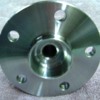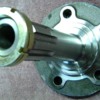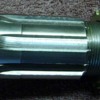Sold as a pair with new axle nuts for.....$378.
Yes, you read that right...$378 a PAIR.
I called and talked with Steve about them. He says they are made of "cold rolled forging EN-19" steel, are machined to duplicate the original DeTomaso forgings, and are stronger than the billet axles that have been going for about $450 each. Drilled completely through the center to provide greater torsional strength.
I ordered them from Steve Wednesday afternoon - they arrived on Friday. Now we have discussed shipping charges from the vendors in earlier posts, and I was waiting to see just how bad a hit I was going to take for these heavy little puppies. The well packed, in a heavy cardboard box, axles tipped the scales at 15 pounds. My shipping, handling, insurance charges? $14.80. That is pretty darn reasonable in my book.
Plus the CA tax gave a total of $423.05.
My stock axles were about the only weak link left on 2511. I have heard a few stories of the stockers snapping at the hub due to the forces encountered with our wide 335's and 'spirited' driving styles.
2511 has Dennis Quella's tapered bearing conversion, so about the only issue I expect from swapping them out will be the wheel studs - everything else is much easier than stock. No 450 foot pounds of torque needed for tapered bearings.
Here are a few photos of them for you guys to oogle over...
Larry




